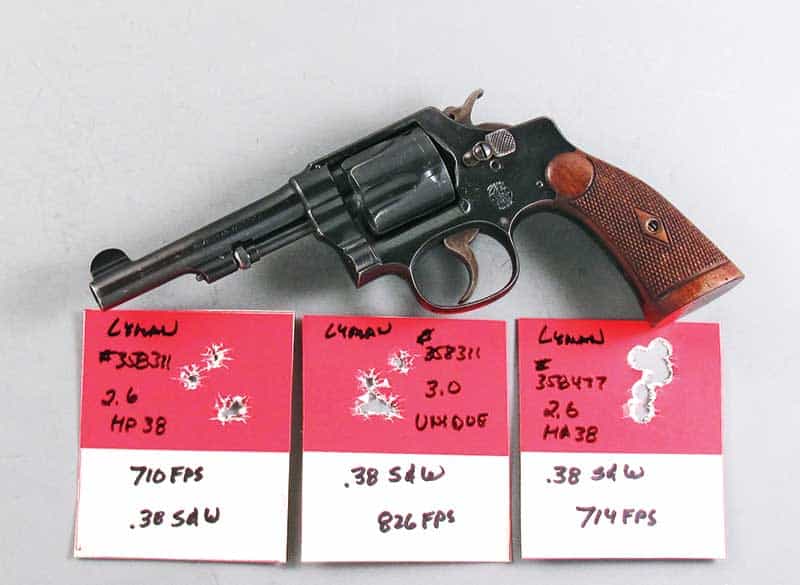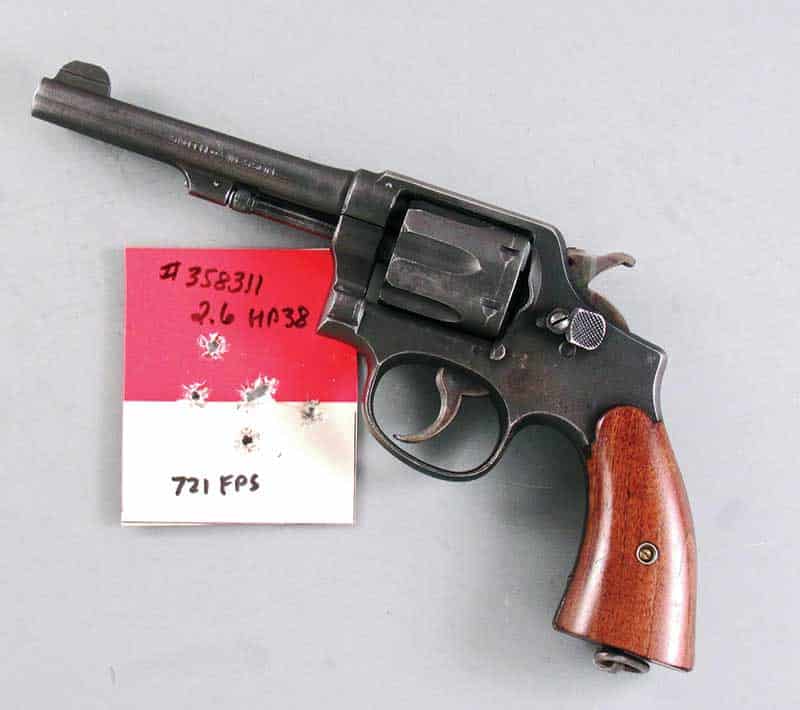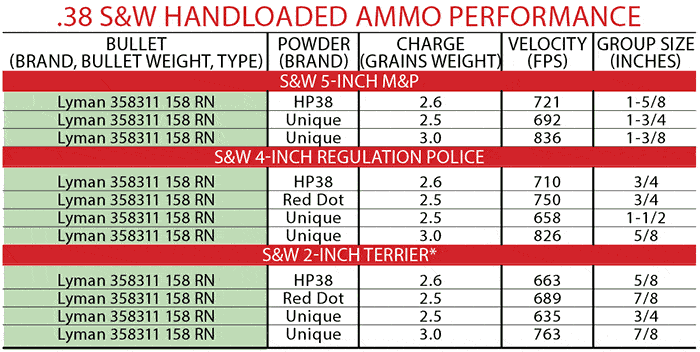The “Other” .38
Reloading The Shorter 19th Century .38 S&W.
The .38 S&W, not to be confused with the .38 S&W Special, is one of our older cartridges. According to who you believe, the .38 Special arrived in 1899 or 1902, while the .38 S&W goes back to 1876-77. Daniel Wesson himself designed the cartridge and it was first chambered in the Smith & Wesson spur-triggered, top-break, single-action revolvers. By 1880, double action top-break .38 S&W’s were being offered.
In 1899 Smith & Wesson introduced the Military & Police revolver and this was used to arm the British during WWII. From 1940 to 1945 nearly 570,000 British Service Model M&P’s were chambered in .38 S&W with a cartridge using a 178-grain FMJ bullet. The British called this round the .380 Mark II.
At the same time the British Service Model M&P’s were being produced over 240,000 Victory Model M&P’s were made for our forces chambered in .38 Special. All of these K-frame sixguns had a Parkerized military-style finish, a lanyard loop in the butt and smooth walnut stocks. At the time these revolvers were made for the British they supplemented the top-break Enfield revolvers which were chambered for the same cartridge
Prior to WWII, S&W offered 5-shot I-frame .38 S&W revolvers known as Regulation Police models produced from 1917 to 1940 and then again from 1949 to 1969.
With a 2-inch barrel and a roundbutt, they were known as the Terrier. First introduced in 1936, the Terrier resumed production in 1948 until 1979.
Around mid-century the .38 S&W had a 145-grain bullet rated at 745 fps while the .38 Special used a 158-grain bullet at 870 fps. When loaded with a 200-grain bullet at 630 fps, the .38 S&W was known as the Super Police, while the .38 Special Super Police used a 200-grain bullet at 745 fps. Colt revolvers were chambered for the .38 S&W; however, at Colt the cartridge was known as the .38 Colt New Police. Same cartridge.
Prior to WWII, S&W offered 5-shot I-frame .38 S&W revolvers known as Regulation Police models produced from 1917 to 1940 and then again from 1949 to 1969.
With a 2-inch barrel and a roundbutt, they were known as the Terrier. First introduced in 1936, the Terrier resumed production in 1948 until 1979.
Around mid-century the .38 S&W had a 145-grain bullet rated at 745 fps while the .38 Special used a 158-grain bullet at 870 fps. When loaded with a 200-grain bullet at 630 fps, the .38 S&W was known as the Super Police, while the .38 Special Super Police used a 200-grain bullet at 745 fps. Colt revolvers were chambered for the .38 S&W; however, at Colt the cartridge was known as the .38 Colt New Police. Same cartridge.
When I first started shooting seriously during the mid-1950’s, there were still plenty of war surplus firearms available, both Victory Models and British Service Models. These were offered at very reasonable prices, however there was a problem as the British .38 S&W’s were often re-chambered to .38 Special resulting in split cases or worse. The .38 S&W had a case-head diameter of 0.3865-inch while the .38 Special measured 0.379-inch, so the chambers were already oversized for .38 Special brass. The .38 Special is also longer than the .38 S&W by nearly 4/10 inch.
Bullet diameters were also different. The 3rd addition of the Lyman Cast Bullet Handbook (1980) recommends .38 Special bullets be sized to 0.357-inch, while the .38 S&W has a recommended size of 0.360-inch.
Col. Rex Applegate was armed with a Smith & Wesson Top-Break .38 S&W when he tried to stop an attacker in Mexico. He had to empty all five rounds. This led to some re-thinking on the part of S&W, and in 1950 the first J-frame .38 Special arrived, allowing for more power in just a slightly larger package.
I never gave the .38 S&W even a fleeting glance until very recently. With all the interest in black plastic guns I found .38 S&W’s lying all alone in the showcases with hardly anyone paying attention to them. Even before this I found two .38 S&W’s on the Internet. (Caution here! When purchasing firearms over the Internet be very sure who you are dealing with.) I bought a 4-inch Colt Police Positive and traded into a very rare 2-inch Colt Bankers Special. Then one weekend I hit three of our gun shops here in the Valley finding a 4-inch S&W Regulation Police at Buckhorn, a 5-inch British Service Model at Boise Gun, and a very nice Smith Terrier at our local Cabela’s. With these five classic sixguns I have less money invested than some have put in one Modern Sporting Rifle.
The S&W Terrier is just slightly smaller than the J-frame Chiefs Special while the Colt Bankers Special is just slightly smaller than the Colt Detective Special. Both of these .38 S&W models were slightly enlarged to become the more well-known Chiefs Special and Detective Special chambered in .38 Special. Everything we have liked about the .38 Special 2-inch revolvers also holds true for the short .38 S&W’s. There is only a slight difference in power, however, they handle just as easily, maybe even more so, than the more modern snubbies.
Reloading Considerations
Now it’s time to start reloading for the .38 S&W. I ordered a set of Lee Carbide Dies and found the sizing die in the set marked “.38 Auto,” which tells me my .38 Super sizing die could’ve been put to use. I was fortunate to receive three boxes of factory ammunition with the Banker’s Special. I can’t remember the last time I saw .38 S&W ammunition on the shelves. I also lucked out and found 500 rounds of new brass at Starline. The factory loads for the .38 S&W use a 145- to 150-grain bullet rated at about 625 fps from a 4-inch barrel. I found I could come very close to duplicating this load using the Lyman 358311, which is the standard 158-grain roundnosed cast bullet for the .38 Special, over 2.5 grains of HP38.
I also like to use Trail Boss especially in older cartridges such as the .38 S&W. Trail Boss not only gives very pleasant shooting loads, it is very easy to use as you simply fill the case to the base of the bullet without compression. In this particular situation, using the standard Lyman bullet, muzzle velocities are about 100 fps less with very minor recoil. Red Dot powder also works well in the .38 S&W and when I don’t have bullets cast up and ready to go, Oregon Trail’s 158-grain RNFP is an excellent substitute.
Reloading Considerations
I only recently started acquiring .38 S&W sixguns, and I confess I had actually been ignoring several .38 S&W revolvers in my wife’s collection of top-breaks. I went through her inventory and picked out two of the best mechanically. One of these is about 99 percent and fitted with beautiful pearl grips while the other is well-worn as to finish and apparently was carried quite a bit by someone. These guns date back to the 1880’s and should only be used with black powder. I use 148-grain hollowbase wadcutters over 10.0 grains of Hodgdon’s Triple Seven FFFg granulation. This results in a muzzle velocity of right at 600 fps, and surprisingly will put all the shots in 1-inch at a self-defense distance of 7 yards.
I did not expect great results shooting .38 Special bullets sized to .358-inch in .38 S&W sixguns, which called for 0.360-inch bullets. In researching old specifications for barrels I found the .38 Special barrels had groove diameters from 0.354- to 0.357-inch while the specs for the .38 S&W were 0.360- to 0.361-inch. I should not have been concerned as they shoot just fine. I did find it necessary to file a little off the front sight of the British Service Model so the 158-grain bullets would shoot to point of aim in a sixgun originally regulated for 178-grain bullets.
I got a real surprise when I checked the older reloading manuals for powder charges in the .38 S&W. I found maximum charges listed as high as 4.0 grains of Unique. Currently this a standard load for the .38 Special, so I cut it to 3.0 grains for my first loads and found this is hotter than I wanted for continued use in some of these sixguns which date back before World War II or even further. Trying both Lyman’s 358311 RN and 358477 SWC, both weighing around 158 grains, over 3.0 grains of Unique, resulted in muzzle velocities over 800 fps. My goal was no more than 650 to 700 fps with these bullets and I found 2.5 grains of Unique did exactly what I wanted. As far as accuracy goes, this load puts five shots from the British Service Model in just over 1-inch at 20 yards. That’s more than I ever would’ve expected.
The 4-inch S&W Regulation Police and Colt Police Positive, and the 2-inch S&W Terrier and the Colt Bankers Special were designed for up-close self-defense use. So with that in mind I shot all of them extensively at 7 yards. Now remember, these are loaded with 0.358-inch bullets instead of the recommended 0.360 size. The results were absolutely amazing. All of these guns shot as well, or better, than currently produced sixguns and semi-automatics designed for the same purpose and using bullets closer to the proper size. Many of the loads, especially with the Lyman cast bullets, average 1-inch or less from these old revolvers.
The .38 S&W is fast approaching 140 years of age. While I certainly wouldn’t have it up high on my list of self-defense cartridges, I would not feel helpless if it was all I had.
Lyman Products
475 Smith St.
Middletown, CT 06457
(800) 225-9626
www.lymanproducts.com
Hodgdon Powder Co.
6430 Vista Dr.
Shawnee, KS 66218
(913) 362-9455
www.hodgdon.com
Alliant Powder
P.O. Box 856
Lewiston, ID 83501
(800) 379-1732
www.alliantpowder.com
Oregon Trail Bullets
P.O. Box 529
Baker City, OR 97814
(800) 811-0548
www.oregontrailbullets.com
Read More Handloading Articles

Get More Revolver Content Every Week!
Sign up for the Wheelgun Wednesday newsletter here:









